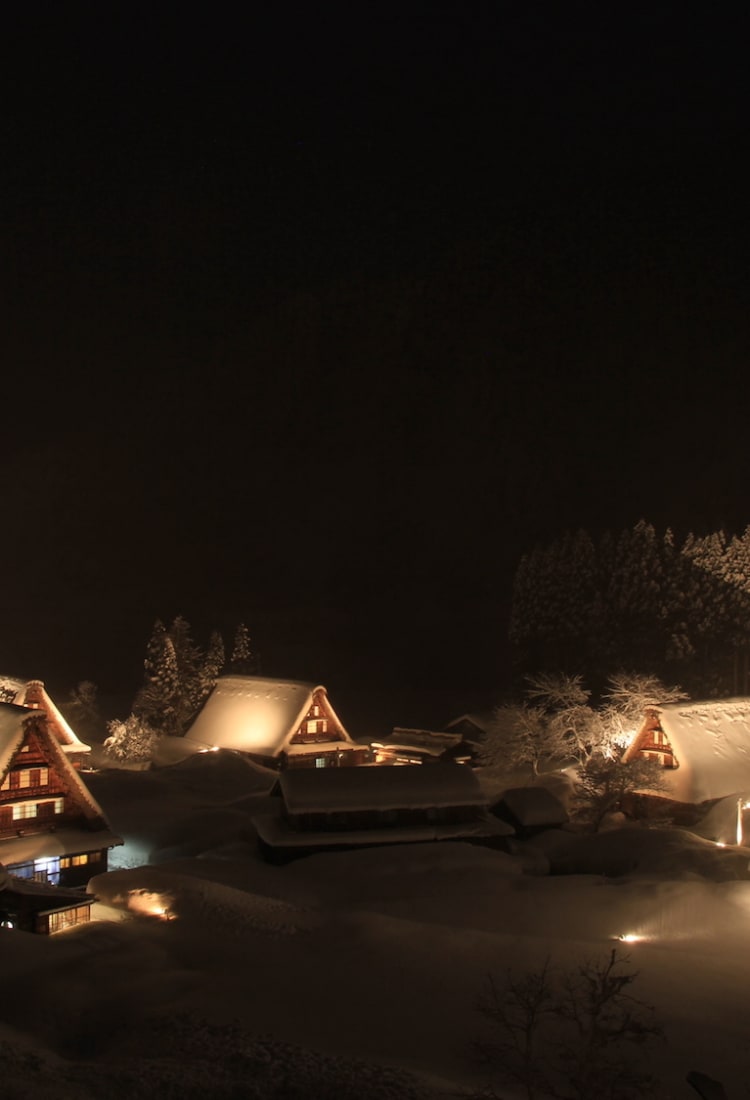

TOYAMA Gokayama Traces of a vanished world in the heart of rural Toyama
Traces of a vanished world in a corner of Toyama
Step into a pocket of unexplored history with a trip to UNESCO-listed Gokayama.
Don't Miss
- The carefully preserved gassho-zukuri buildings of Ainokura and Suganuma
- Spending the night at one of Ainokura's gassho-zukuri inns
- Light up events in Suganuma

How to Get There
Gokayama can be accessed through a combination of trains and buses.
For those already in Toyama , Takaoka and Shin-Takaoka stations serve as the central hub for the area. From Shin-Takaoka Station, take the World Heritage Bus for a one-hour direct trip to Gokayama. From Takaoka Station, take the Johama Train Line to Johana Station (50 minutes) and catch a 25-minute bus to Gokayama.
A glimpse of old Japan
With their carefully preserved gassho-zukuri buildings, Gokayama is full of charm and simplicity. In summer, they offer a relaxing retreat from the big city bustle in lush nature, while in winter the snowy rooftops create scenes of rustic beauty.

Say a little prayer
Ainokura and Suganuma are the modern names of the historical villages Taira and Kamitaira. Their famed “praying hands” buildings—so named for the thatched roofs resembling hands joined in prayer—range in age from one hundred to four hundred years old.
These days, you can only see gassho-style villages in Toyama and neighboring Gifu Prefecture. Gifu is home to the UNESCO-listed Shirakawa-go . Ainokura and Suganuma present rare and precious opportunities to experience a different side of Japanese culture.



Nature intertwined with culture
The appeal of Gokayama centers on the area's seamless blend of nature and culture. Unlike many other UNESCO sites in Japan, the traditional buildings here don't have to compete with modern urban environments. Instead, their rural setting preserves the natural harmony between the countryside and grass-thatched structures that almost seem to have sprouted from the earth.
The setting evokes a simpler time preserved in the sturdy buildings and peaceful walks of Gokayama now all but vanished into the cultural memory of Japan.

Don't judge a gassho-zukuri by its cover
Appreciating gassho-zukuri goes beyond admiring their external appearance. Some of the gassho-zukkuri houses have been converted into quaint eating establishments and lodgings, reflecting their historical role as traditional minka dwellings. Consider staying a night in Gokayama to immerse yourself in the ancient charm.
While walking the streets may be akin to exploring an open-air museum, staying at a traditional minka and sampling local delicacies within their walls further enhances the old-world experience.

Feel the warmth
Even if you don't stay in a gassho-zukkuri house, you can see inside one at the exhibition hall. When seen from within, the gassho-zukuri structures reveal a range of clever subtleties, such as the open lofts that served as spaces for silkworm cultivation. More than that, there is a palpable feeling of warmth to the old wood interiors that is best experienced firsthand.

When to Go
The Ainokura Gassho-zukuri village is open 7 days a week from 8:30 am to 5 pm.
The Suganuma Gassho-zukuri village is open from 8 am to 5 pm and closed for the year-end and New Year holidays.
The villages of Ainokura and Suganuma hold occasional light up events during the year.






























































